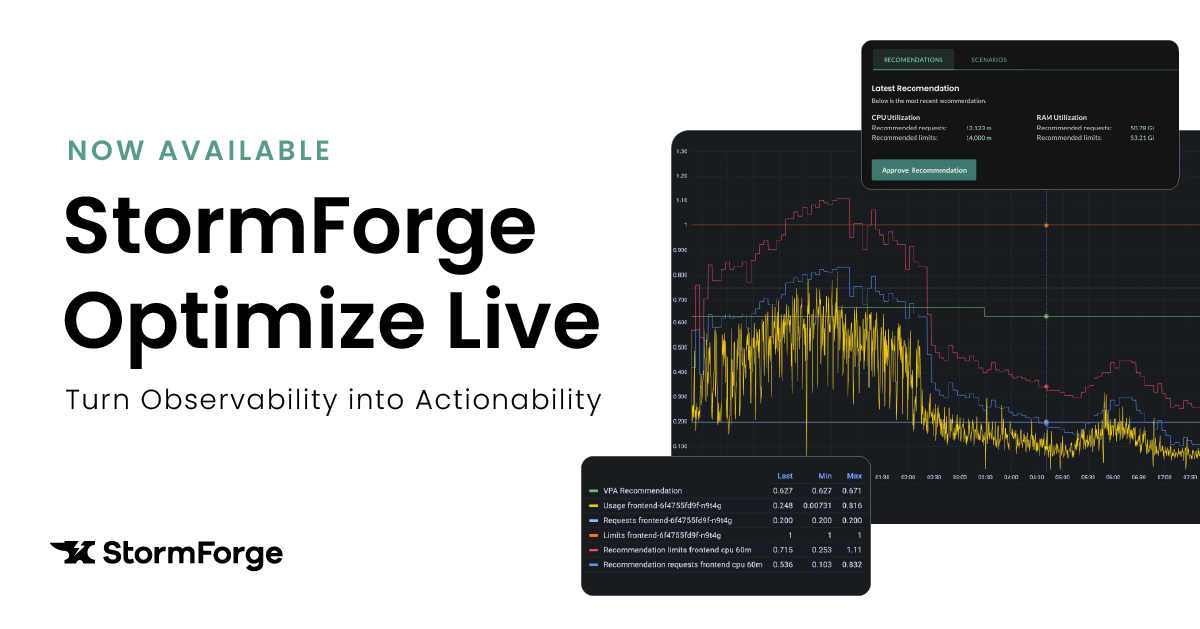

At StormForge, we have a vision for our customers:
What if you could ensure your cloud native environment was never over-provisioned, while still meeting SLAs and SLOs, without manual tuning, so dev teams could focus their efforts on innovating?
Until now, we’ve been helping customers work toward that vision through a process of scenario analysis in non-production environments. This experimentation-based approach to optimization uses load testing to simulate any scenario you can imagine. StormForge machine learning can then identify the best resource settings to optimize for cost and performance before deployment. As a bonus, you can get deep insights into your application behavior to drive architectural improvements.
While that’s incredibly powerful, we know that in today’s cloud native, DevOps world your job doesn’t end with deploying an application to production. Applications, infrastructure, and user traffic patterns are constantly changing. You’ve adopted observability tools to help rein in that complexity, but it’s difficult to know what actions to take based on what you’re seeing.
Optimize Live is our new solution that closes this data-to-value gap. It leverages the wealth of observability data you’re already collecting, using machine learning to provide actionable insights for improving the efficiency of your Kubernetes production environment.
Optimize Live helps enterprises reduce resource slack and the associated cloud costs, and reduce risk of CPU throttling and out-of-memory errors that result in user experience issues. Optimize Live fits into your existing ecosystem, integrating with observability solutions like Prometheus and Datadog to deliver value quickly, with minimal time and effort needed to get started.

Resource slack is wasted CPU or memory – resources that are allocated (and paid for) but not used. On average, IT professionals estimate that 48% of their cloud spend is wasted on unused or idle resources.
StormForge Optimize Live reduces resource slack proactively through advanced machine learning. It looks at historic usage and trends and then predicts and recommends resource needs going forward, resulting in resource allocation that closely tracks actual usage. This approach results in significantly improved resource efficiency and cost savings compared to a time-consuming trial-and-error approach.
The time-series visualization example below shows how tightly StormForge is able to keep resource requests to actual usage. Note that any gap between the light blue line (baseline CPU request) and the dark blue line (CPU recommended by StormForge) is wasted resource that would be eliminated by using Optimize Pro.

Another benefit of the advanced machine learning used by StormForge Optimize Live is a reduced risk of application performance and user experience issues. In an environment using either static resource requests and limits, or a reactive approach based on simple statistics, actual resource needs can often exceed allocated resources. When this happens, CPU throttling and out-of-memory errors can occur, resulting in slow performance, user experience, and availability issues.
Try StormForge for FREE, and start optimizing your Kubernetes environment now.
It’s easy to get started using Optimize Live. Just specify the namespace for your application and Optimize Live will find which resources can be tuned, then enable recommendations. To do this, you just need to specify a few things like min and max CPU and memory settings, your risk tolerance, how frequently you want Optimize Live to provide recommendations, and whether you want to implement those recommendations automatically or with a manual approval step.
That’s all there is to it! Our machine learning will now start analyzing actual usage and performance to start making recommendations to keep your production environment running efficiently.

Optimize Live and Optimize Pro (the new name of our existing solution) together are a powerful combination.
With Optimize Pro, you get an experimentation-based approach to optimization. It works in non-prod environments using load testing to simulate production traffic. It provides deep application insights that help you understand your application’s behavior and drive architectural improvements. It’s powerful, giving you full control to optimize any parameters for any goals you might have. We recommend using it for any applications that are complex and mission-critical, or for those that you’ve built load tests for.
Optimize Live gives you an observation-based approach to optimization. It looks at observability data and uses machine learning to recommend CPU and memory settings for improved efficiency on an ongoing basis in production. It will reduce resource usage and cost while also reducing the risk performance and availability issues caused by CPU throttling and out-of-memory errors. We recommend using it on all of your Kubernetes-based applications. It’s so fast and easy to get value from that there’s no reason not to use it far and wide.
Here is a side-by-side comparison of the two solutions:
| Optimize Pro | Optimize Live | |
| Optimization approach | Experimentation-based using machine learning | Observation-based using machine learning |
| Best used for | Complex, mission-critical Kubernetes applications | All Kubernetes applications |
| Environment | Non-prod | Prod or non-prod |
| Data input | Optimizes for wide range of scenarios using load testing | Optimizes based on actual utilization and observability data |
| Goals and parameters | Optimizes for any goal by tuning any parameter | Recommends CPU and memory requests & limits for improved efficiency |
| Adoption of recommendations | Presents set of recommended configurations, user chooses based on business trade-offs | Recommendations at chosen frequency can be automatically implemented or manually approved |
| Intangibles | Provides deep application insights to drive architectural improvements | Simple configuration, fast time-to-value |
Want to learn more about Optimize Live? Here are a few more resources:
We use cookies to provide you with a better website experience and to analyze the site traffic. Please read our "privacy policy" for more information.